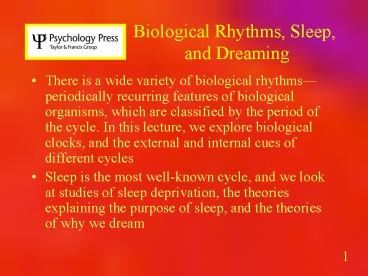Biological Rhythms, Sleep, and Dreaming - PowerPoint PPT Presentation
1 / 24
Title:
Biological Rhythms, Sleep, and Dreaming
Description:
There is a wide variety of biological rhythms periodically ... spiny anteater does not have REM. 23. Psychological theories. Freud's wish-fulfilment theory ... – PowerPoint PPT presentation
Number of Views:191
Avg rating:3.0/5.0
Title: Biological Rhythms, Sleep, and Dreaming
1
Biological Rhythms, Sleep, and Dreaming
- There is a wide variety of biological
rhythmsperiodically recurring features of
biological organisms, which are classified by the
period of the cycle. In this lecture, we explore
biological clocks, and the external and internal
cues of different cycles - Sleep is the most well-known cycle, and we look
at studies of sleep deprivation, the theories
explaining the purpose of sleep, and the theories
of why we dream
2
Biological Rhythms
3
Different Kinds of Biological Rhythms
- Circadian rhythm
- About a day
- 24 hours
- Ultradian rhythm
- Less than a day
- 90 minute cycles of lighter and deeper sleep
- Infradian rhythm
- Greater than one day
- Menstrual cycle
4
The SleepWaking Cycle A Circadian Rhythm
- Biological clock
- Siffre (1975)
- Wever (1979)
- Folkard (1996)
- Endogenous factors
- Suprachiasmatic nucleus (SCN)
- the amount of light entering the eye
- pineal gland
- melatonin
5
(No Transcript)
6
(No Transcript)
7
- Exogenous factors
- Campbell and Murphy (1998)
- Light as the dominant zeitgeber or timer
giver - Miles et al. (1977)
- Luce and Segal (1966)
- Internal and external control
- Shiftwork
- Jet lag
- Indirect effects of circadian rhythms
- Blake (1967)
8
The Menstrual Cycle An Infradian Rhythm
- Governed by hormones
- oestrogen
- progesterone
- 28 days
- Reinberg (1967) external cues
- McClintock (1971)
- synchronised cycles through pheromones of other
women - synchronised cycles through pheromones of men
9
Circannual Rhythms
- Rhythms that last for about 1 year or more
- Hibernation
- Seasonal Affective Disorder (SAD)
- Severe depression during the winter months
- Seasonal variation in the production of melatonin
(Barlow Durand, 1995) - More common in northern latitudes where winter
days are very short (Terman, 1988) - Phototherapy (Barlow Durand, 1995)
10
The Consequences of Disrupting Biological Rhythms
- Jet lag
- Changing time zones
- Klein et al. (1972) westbound flights less
disruptive to the sleepwaking cycle than
eastbound flights - Melatonin and aircrew
- Shiftwork
- Moore-Ede (1993) shiftworker fatigue
- Monk and Folkard (1983)
11
Sleep
12
Stages of Sleep An Ultradian Rhythm
- Stage 1
- Relaxation with synchronous brain waves
- Stage 2
- EEG becomes slower and larger
- Stage 3
- EEG consists of long, slow delta waves
- Stage 4
- Slow-wave sleep (SWS)
- Stage 5
- Rapid eye movement or REM sleep
13
1 2 3
Examples of EEGs from various stages of sleep
14
4 5
15
Cyclic variations in EEG during sleep and their
relation to eye movements, body motility, and
dreaming
16
REM Sleep and Dreaming
- Aserinsky and Kleitman (1955)
- First discovered the association between REM
sleep and dreaming - Dement and Kleitman (1957)
- Between 70 and 75 of participants woken in REM
sleep report dreaming - Green (1994)
- 30 of sleepers in SWS report dreaming
- REM dreams
- Are vivid and detailed
- Non-REM dreams
- Are vague and less coherent
17
Studies of Sleep Deprivation
- Famous cases
- Peter Tripp 8 days (200 hours)
- Randy Gardner 11 days (264 hours) (Horne, 1988)
- Rechtschaffen et al. (1983)
- sleep deprivation in rats
- Lugaressi et al. (1986) 52-year-old man who could
not sleep due to damage to parts of the brain
regulating sleep - REM deprivation
- Dement (1960)
- Jouvet (1967)
- Task performance
- Effects over time
- Partial deprivation
18
Theories of Sleep
- Recovery or restoration theories
- Physiological restoration
- Psychological functions
19
- Adaptive or evolutionary theories
- Sleep as a protection against predation
- Meddis (1975)
- Hibernation theory
- Webb (1982)
- Recovery or adaptation?
- Horne (1988) sleep probably serves different
purposes in different species
20
Dreaming
21
The Nature of Dreams
- Remembering your dreams
- 95 of dreams are forgotten
- An objective method for the study of dreaming
- Dement and Kleitman (1957)
- high correlation between amount of time spent in
REM and verbal reports of dreaming - Dreaming and consciousness
- Empson (1989)
- lucid dreams
22
Theories of the Functions of Dreaming
- Neurobiological theories
- Activation-synthesis theory
- Hobson and McCarley (1977)
- dreamers try to make sense of random brain
activation - Reverse-learning theory
- Crick and Mitchison (1983)
- gets rid of useless information stored in the
brain - spiny anteater does not have REM
23
- Psychological theories
- Freuds wish-fulfilment theory
- dreamers dream of repressed desires
- manifest content of dream is latent content
disguised - Problem-solving theory
- Webb and Cartwright (1978)
- problem-solving after sleepsleep on it
- manifest content is the real content
- Survival strategy theory
- Winson (1997)
- memories of new experiences are placed close
together with older memories to form a strategy
for survival
24
PowerPoint Presentations by Eamon Fulcher

